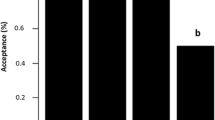Summary
Nymphs ofAgriosphodrus dohrni Signoret (Reduviidae) have a strong gregariousness and show group predatory behavior. This study was conducted to clarify adaptive significance of group predation of this species, including laboratory observations and 6-year field surveys.
In the laboratory, observations on both solitary and group attacking against armyworms were made at varying prey size classes to compare the capture success rate by solitary predators with that by groups. The efficiency in capturing the prey was significantly higher in group attacking at any prey size class compared.
Data obtained from the field surveys indicated the tnedency for searching nymphs to feed in group and to increase the number of predators feeding per prey item with increasing prey size. Average sizes of prey captured were also larger in group feeding throughout the nymphal stage. In particular, it was remarkable that, when prey were “creeping” types, the upper size limit of prey eaten was dramatically increased.
Similar content being viewed by others
References
Brach, V. (1977)Anelosimus studiosus (Araneae: Theridiidae) and the evolution of quasisociality in theridiid spiders.Evolution31: 154–161.
Burgess, J. M. (1976) Social spiders.Scient. Amer.234: 100–106.
Chadab, R. andC. W. Rettenmeyer (1975) Mass recruitment by army ants.Science118: 1124–1125.
Cody, M. L. (1974) Optimisation in ecology.Science183: 1156–1164.
Darchen, R. (1965) Ethologie d'une staignee sociale,Apelena consociataDenis.Biol. Gabonica.1: 117–146.
Emlen, J. M. (1966) The role of time and energy in food preference.Amer. Natur.100: 611–617.
Griffiths, D. (1975) Prey availability and the food of predators.Ecology56: 1209–1214.
Griffiths, D. (1980) Foraging costs and relative prey size.Amer. Natur.116: 743–752.
Heinrich, B. andF. D. Vogt (1980) Aggregation and foraging behavior of whirligig beetles (Gyrinidae).Behav. Ecol. Sociobiol.7: 179–186.
Hogland, J. L. andP. W. Sherman (1976) Advantages and disadvantageas of bank swallow (Riparia riparia) coloniality.Ecol. Monogr.46: 33–58.
Inoue, H. (1982) Studies on the mode of foraging of the gregarious assassin bugAgriosphodrus dohrniSignoret.Res. Popul. Ecol.24: 211–223.
Inoue, H. (1983) Nymphal cannibalism in relation to oviposition behavior of adults in the assassin burg,Agriosphodrus dohrniSignoret.Res. Popul. Ecol.25: 189–197.
Kleiman, D. G. (1966) The comparative social behavior of the Canidae.Amer. Zool.6: 182.
Katz, C. L., M. J. Potel andR. J. Wassersug (1981) Structure and mechanisms of schooling in tadpoles of the claswed frog,Xenopus laevis.Anim. Behav.29: 20–33.
Krafft, B. (1966) Etude du comportement social de l'AraigneeAgelena consociataDenis.Biologia Gabonica2: 235–250.
Kruuk, H. (1972)The Spotted Hyena. Univ. of Chicago Press. Chicago and London.
Kullmann, E. J. (1972) Evolution of social behavior in spiders (Araneae; Eresidae and Theridiidae).Amer. Zool.12: 419–426.
MacArthur, R. H. andE. R. Pianka (1966) On optimal use of a patchy environment.Amer. Natur.100: 603–609.
Roth, L. M. (1961) A study of the odoriferous glands ofScaptocoris divergens (Hem.: Cydnidae).Ann. Entomol. Soc. Amer.54: 900–911.
Schaller, G. B. (1972)The Serengeti Lion. Chicago Univ. Press. Chicago.
Shoener, T. W. (1971) Theory of feeding strategies.Ann. Rev. Ecol. Syst.2: 369–404.
Siegfried, W. andL. G. Underhill (1975) Flocking as an anti-predator strategy in doves.Anim. Behav.23: 504–508.
Treherne, J. E. andW. A. Foster (1980) The effects of group size on predator avoidance in a marine insect.Anim. Behav.28: 1119–1122.
Wyman, J. (1967) The jackals of the Serengeti.Animals10: 79–83.
Wilson, E. O. (1958) The beginnings of nomadic and group-predatory behavior in the ponerine ants.Evolution12: 24–31.
Author information
Authors and Affiliations
Rights and permissions
About this article
Cite this article
Inoue, H. Group predatory behavior by the assassin bugAgriosphodrus dohrni Signoret (Hemiptera: Reduviidae). Res Popul Ecol 27, 255–264 (1985). https://doi.org/10.1007/BF02515464
Issue Date:
DOI: https://doi.org/10.1007/BF02515464




